The Italian Straw Hat (1927)
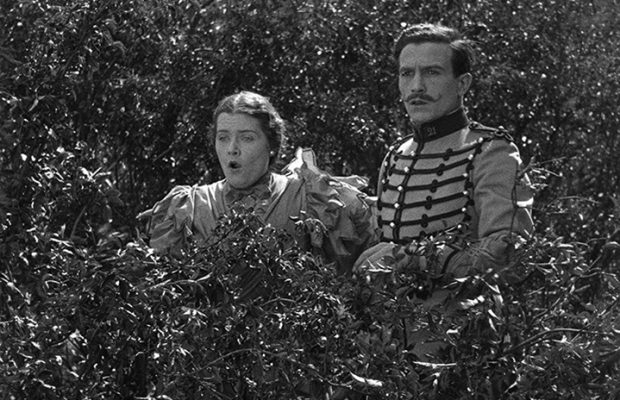
Toronto Film Society presented The Italian Straw Hat (1927) on Monday, February 27, 1967 as part of the Season 19 Monday Evening Silent Film Series, Programme 4.
(Main Auditorium, UNITARIAN CHURCH, 175 St. Clair West)
~~~~~~~~~~~~~~~~~~~~~~~~~~~~~~~~~~~~~~~~~~~~~~~~~~~~~~~~~~~~~~~~~~~~~~~~~~~~~
Programme No. 4
Monday February 27, 1967
8:15 pm
“Vive la France!”
1907: Fun After the Wedding (Zecca) c13 min
1908: The Doctor’s Secret (Méliès) c12 min
1927: The Italian Straw Hat (René Clair) 1 hr 25 min
~~~~~~~~~~~~~~~~~~~~~~~~~~~~~~~~~~~~~~~~~~~~~~~~~~~~~~~~~~~~~~~~~~~~~~~~~~~~~
Preamble: 1927
So far this season our films have mostly come from either 1916 (Intolerance and Teddy at the Throttle) or 1920 (High and Dizzy, The Cradle of Courage, Excuse My Dust and The Mollycoddle). For the remaining three programs of the season, however, our features all come from the year 1927.
There is no special significance in this; we chose the films first and noticed their dates afterwards. But it must be admitted that 1927 was a rather interesting year . . which you can read all about in The Year the World Went Mad by Allen Churchill. If nothing else it was the year that 27-year-old Charles Lindbergh made his famous flight to Paris. In the sports world they still talk about the famous Depsey-Tunney “long count” fight, and of Bobby Jones winning the British Open Golf Championship. Does anyone remember Peaches Browning? Ruth Snyder and Judd Gray? Trader Horn? Sinclair Lewis’s Elmer Gantry and Willa Cather’s Death Comes for the Archbishop were high on the best-seller list. Broadway musicals included “Rio Rita”, “Hit the Deck”, “Good News” and “A Connecticut Yankee”.
The Academy of Motion Picture Arts and Sciences was founded that year. Among the outstanding films of 1927: Wings, The King of Kings (Cecil DeMille’s), Seventh Heaven, Sunrise, Buster Keaton’s The General, Greta Garbo and John Gilbert in The Flesh and the Devil, Sternberg’s Underworld and The Last Command, Clara Bow in It, Laura LaPlante in The Cat and the Canary, Metropolis (released in North America that year though made the year before), Ramon Novarro and Norma Shearer in The Student Prince, Douglas Fairbanks in The Gaucho, Mary Pickford in My Best Girl (with Buddy Rogers, now her husband). And for a random sampling of films that you younger ones have never heard of and your parents have completely forgotten: Sue Carol and Douglas MacLean in Soft Cushions, Bebe Daniels in She’s a Sheik, John Gilbert and Jeanne Eagels in Man, Woman and Sin, Marion Davies and Johnny Mack Brown in The Fair Co-ed, Anna Q. Nilsson and Babe Ruth in Babe Comes Home, Ronald Colman and Vilma Banky in The Night of Love, Louise Brooks and Richard Arlen in Rolled Stockings . . (Come to think of it, why are we doing only three films from 1927?) And around October The Jazz Singer, with half-a-dozen songs and a brief dialogue sequence, come out and became a smash box-office hit in those few Warner Brothers theatres that were wired for sound. It was the beginning of the end of silent films. Hollywood didn’t know it yet, but 1927 was its last year of security. 1928 was to be the Year of the Revolution, when filmmakers frantically converted from silents to talkies.
The differences in style between the 1920 films and the 1927 films will be immediately obvious to all; but though this is a historical fact, our samples do stack the cards somewhat. Our three 1920 features were more or less typical Hollywood films of their day; but this isn’t the case with our three 1927 films. For one thing, one is not an American film at all, but French; and the other two were made by imported German directors whose first Hollywood assignments these were. But these facts in themselves are indicative of what was happening to Hollywood.
Meanwhile, in 1927 Lindbergh flew to Paris . . and for tonight’s program so do we.
René Clair and The Italian Straw Hat
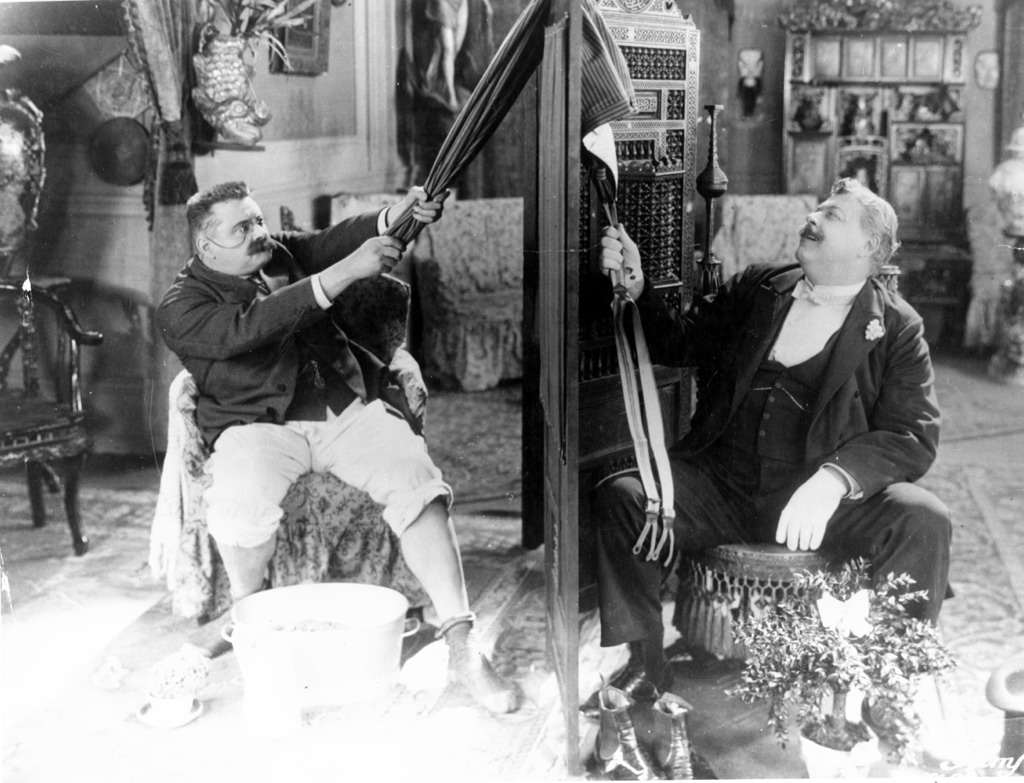
René Clair began his career as a journalist, became a film actor, appeared in several films by Louis Feuillade and one by the Russian emigré, Protazanov, before he was made assistant director to Baroncelli. When he undertook his first independent film it was with the conviction that the French cinema had taken a wrong direction around 1907, and that the remedy was to turn back again for inspiration to its humble but pure beginnings, to the films of Méliès and Zecca, and–above all–to playfulness, movement and unreality.
(MMA FILM NOTES)
And accordingly, before turning to the work of René Clair himself we are opening our program with sample films of both Méliès and Zecca.
Fun After the Wedding
Produced around 1907 by Pathé Frères, Paris
Directed by Ferdinand Zecca
..In France it was the early chase films and trick films that proved most popular. As pictures grew longer–stretching from one minute to ten–these merged into the mad, completely Gallic little farces of men like Ferdinand Zecca, Emile Cohl and Jean Durand. Their construction could not be simpler. Some incident–pumpkins rolling off a wagon, or merely a pretty girl walking down a street–gets a chase under way and then, with incredible inventiveness, complication is piled on complication, camera trick on camera trick, gag upon gag until, with a final flourish, everything is righted again and life goes on as unruffled as before. The progress of such films as Zecca’s Slippery Jim (c1906) or Cohl’s The Pumpkin Race (1907) is completely straightforward, adding incident to incident without recourse to Porter’s more elaborate (and essentially more cinematic) construction. But, shot generally on the streets of Paris, they possessed a superb momentum of their own–and an inspired experimentation with the camera itself. All its resources were explored–fast motion, slow motion, stop motion, reversing the film, superimpositions and ghost effects, comic appearances and disappearances–and always with a lively disregard for the laws of nature and man. It was these comedies that made such an impression on the youthful Mack Sennett and, as he has frankly stated, proved the inspiration for much of his own work as Master of the Revels at Keystone.
(Arthur Knight in THE LIVELIEST ART, p.27-8)
Zecca came to films with Charles Pathé, who began as an itinerant showman of phonograph records at rural fairs and markets. With the early Pathéfilms Zecca acted as commentator: there were no subtitles and simple audiences sometimes required explanations. He continued for many years as Pathé’s collaborator, making hundreds of films and sometimes acting in them. Less imaginative, in some ways less creative than Méliès, he was also more various, violent and popular…
Zecca’s work included trick films with florid painted backdrops and pantomime-goblins and pictures in which inanimate objects became active, hats danced a jig or boots went for a walk by themselves. Along with these he made melodramas galore and he also made “chase” films which were one of the first and most enduring attractions. The Runaway Horse is an ancestor not only of the Keystone comedies, but of the early Chaplins and, through them, of René Clair.
…Unless it be for his realistic melodramas, it is as a maker of trick films that Zecca may be most prized. He was not the only man to make such subjects, but he showed a particular facility for them, proving himself a master of the unlikely and–from a strictly decorous or law-abiding point of view–the undesirable…. The free farce of Fun After the Wedding (c1907) points backwards to circus foolery, but also forward to Keystone comedy.
(MMA FILM NOTES)
Hydrotherapie Fantastique (The Doctor’s Secret)
Produced and directed by Georges Méliès
In the year 1929 (two years after The Italian Straw Hat was made), someone walking through the Gare Montparnasse in Paris did a double-take, recognizing the old man selling toys and candy at a little stand as the once-famous Georges Méliès, whose films between 1896 and 1914 had delighted the world and had introduced numerous new ideas in film-making. It is claimed, for instance, that in his little film Cinderella (1900) he was the first to tell a story on the screen (as opposed to showing “actualities” or a succession of staged incidents).
He was born in 1861, became a professional stage magician, and by 1888 had his own theatre. One day in December 1895, in the basement of a café near this theatre, Louis Lumière and his brother Auguste gave the first public exhibition in Paris of their newly invented machine for projecting moving pictures onto a screen. The demonstration first showed nothing more spectacular than the workers coming out of their factory; but as we know, the medium is the message, and this message was very exciting to that first audience, among whom as Georges Méliès As soon as he could, Méliès acquired a “cinématographe” of his own, and by April 1896 he had made his first film and shown it in his theatre. Sometime later in that year he discovered quite by accident that if you stop cranking the camera just long enough for the person in front of it to move out of the way, on the screen that person appears to vanish into thin air–and what professional magician could resist a trick like that? At any rate, this stimulated his imagination, and he seems to have been the first filmmaker to exploit the move camera’s possibilities for trick photography. His example was quickly followed by his fellow-countrymen throughout most of the first decade of the 20th century.
Méliès best known films (e.g. A Trip to the Moon, 1902, a stock item on the Film Society circuit) exhibited a delightful sense of fantasy and imagination and zaniness–in spite of the fact that he never seems to have freed his films from the confines of a theatrical stage, with the camera, however tricky, always seated squarely in the royal box. (But it’s unfair to forget that this immobility was forced on the early filmmakers by the enormous size and weight of the primitive movie cameras. Throughout film history stylistic advances are often merely the result of mechanical improvements). Nor was Méliès a very good business man. He continued the early practice of selling his prints outright, instead of renting them; thus everyone else made money from the films but him. The 1914 war put an end to his film making.
After they found him in 1929 he was feted and publicized and made much of as a great pioneer, and in 1931 he was made a Chevalier of the Légion d’Honneur. For the rest of his life he lived in the French film industry’s Maison de Retraite, dying on January 22, 1938–still vainly hoping that someone would invite him to make another film.
Re The Doctor’s Secret, the Museum of Modern Art supplies the following note:
Films were made at first to amuse unsophisticated people. They were consequently a form of entertainment in which the spirit of comedy was free and unrefined. The pranks of naughty boys, the humors of undress and obesity, physical mishaps of all kinds were meat for the early movies.
Méliès combined with a rabelaisian sense of humor a gift for imagining new kinds of machinery. Both are apparent in this early film, somewhat clinical for present tastes.
(MMA FILM NOTES) (1949)
* * *
The “wrong direction” which René Clair felt the French film had taken “around 1907” is undoubtedly a reference to the emergence and influence of the Film d’Art, a new company which sought to raise the lowly cinema to the upper slopes of Mount Parnassus by bringing to the screen intact the great classics of the theatre. Their intentions were lofty and laudable, and it must be admitted that they did succeed in conferring prestige on the movies, albeit for the wrong reason, and luring into the movie houses a new class of respectable people who had never ventured inside one before. (It will be remembered that the spreading popularity of movies, like early Christianity, was originally confined to the lower classes; genteel people considered them vulgar). But in filming stage plays they were throwing out the window all the valuable lessons that the pioneer filmmakers had been learning by experience and uninhibited imaginations in the previous twelve years, and the French film lost considerably more than it gained. Such, at any rate, was the conviction of René Clair . . to whom we now return.
The TFS Main Series showed Clair’s Les Deux Timides (1928) earlier this season (Dec 12, 1966), and for biographical data and complete filmography we refer you to the program notes for that date. For those who haven’t those notes: René Clair was born in Paris in 1898, and like several other French filmmakers of more recent years he was a film critic before he turned to making the things himself. He was 25 when he made his first film, Paris qui dort (The Crazy Ray, and he was 29 when he made The Italian Straw Hat. Then came Les deux timides; then three talkies which are still Film Society classics: Sous les toits de Paris, Le Million and A Nous la liberté. In 1935 he made The Ghost Goes West for a British company, and made several Hollywood films in the early 1940’s. He was still active in French films up till five years ago.
Un Chapeau de Paille D’Italie (The Italian Straw Hat)
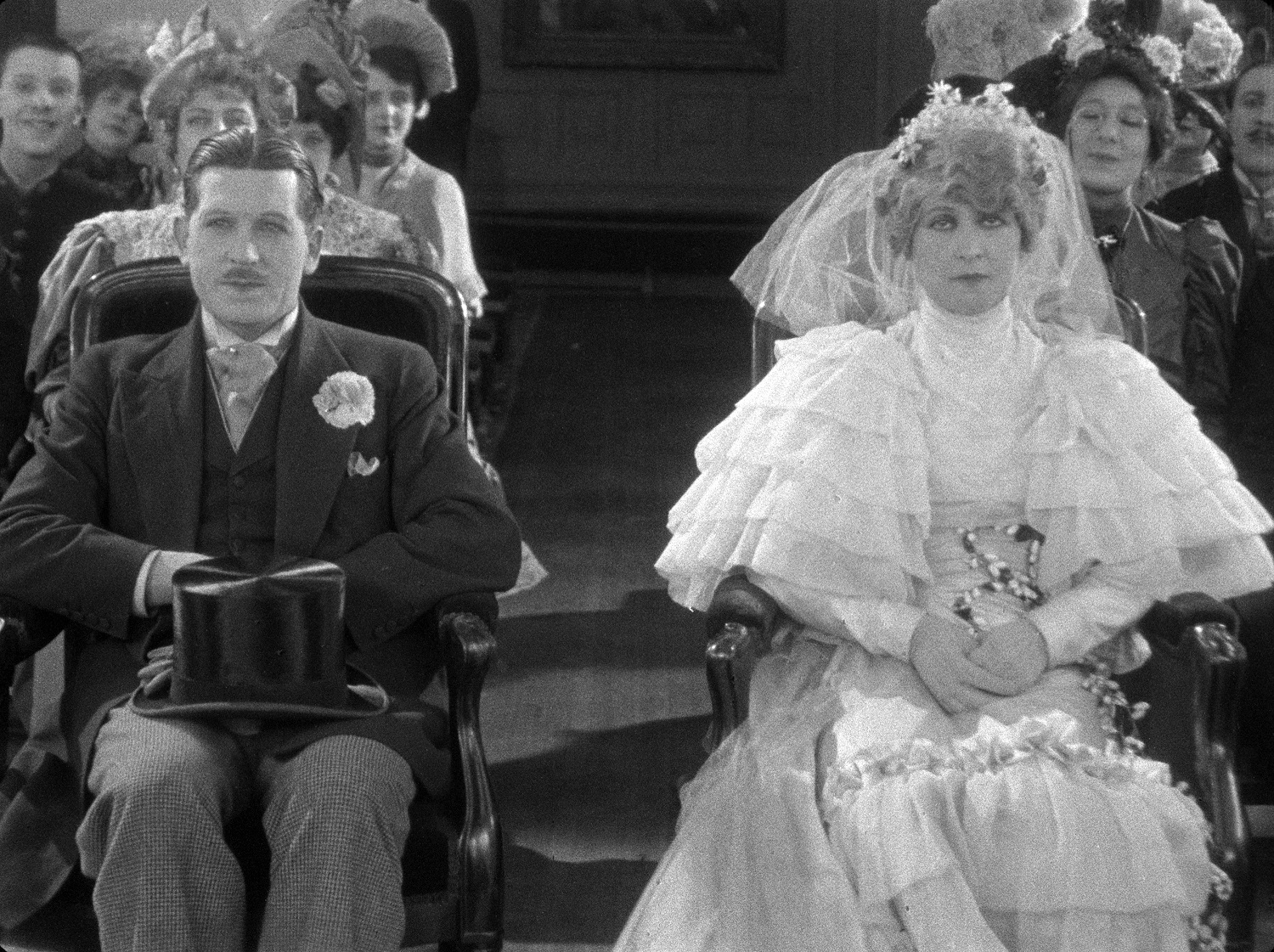
Produced by Albatros (1927)
Directed by René Clair
Adapted from the play by Eugène Labiche and Marc-Michel
Photographed by Nicholas Roudakoff and Maurice Desfassiaux
Designed by Lazare Meerson
CAST
The Bridegroom………………………………Albert Préjean
The Bride………………………………………..Marise Maia
The Officer………………………………………Vital Geymond
The Married Woman………………………..Olga Tschekowa
The Bride’s Uncle……………………………..Paul Ollivier
The Husband……………………………………Jim Gerald
The Bride’s Father…………………………….Yvonneck
The Aunt………………………………………….Alice Tissot
The Man with the Necktie………………….Bondi
The Man with the Glove…………………….Pré fils
The Valet…………………………………………Alexandrov
The Customer…………………………………..Valentine Tessier
The Mayor……………………………………….Volbert
NOTE: This print comes with its own built-in musical accompaniment on a brand-new sound track.
The Italian Straw Hat is one of the films being presented in the Centennial Commission’s FESTIVAL OF LAUGHTER, a film festival devoted to the ten greatest comedies of the screen, selected from the votes of the 1560 international critics polled by the Canadian Film Institute. (The Festival was presented in Calgary earlier this month; it will be repeated in Ottawa starting April 1).
The film sets the story in the 1890’s, but the play (or more correctly, the “vaudeville”) on which it is based, “Un Chapeau de paille d’Italie” by Eugène Labiche and Marc-Michel (who also wrote “Les deux timides”), was written and first produced in 1851. It was an immediate success, and has been a classic of the French theatre ever since. (Labiche was also co-author of “Le Voyage de Mons Perichon” and “La Poudre aux yeux”, which many of us sweated over in our high school French classes).
A “vaudeville”, incidently, was not what the word means to us nowadays, but was a species of musical comedy popular in France in the 19th century: a play with songs. The songs generally had new and appropriate lyrics, but they were (usually) set to already existing melodies–as in “The Beggar’s Opera”, which, had it been French and produced a century later, would have been called a vaudeville. Jacques Ibert’s witty and popular “Divertissement” is a concert suite drawn from the music he wrote for a 1930 revival of “Un Chapeau de paille d’Italie”.
In Victorian times W.S. Gilbert made two very free adaptations of the play: “The Wedding March” and “Haste to the Wedding”; and in 1936 it was adapted by Orson Welles and Edwin Denby as “Horse Eats Hat” and produced by the Federal Theatre Project. There’s a translation of “An Italian Straw Hat” in Volume 3 of Eric Bentley’s “The Modern Theatre” (Doubleday Anchor, 1955), and some of you may remember that it was produced at the Crest a few years ago.
For René Clair, however, the Labiche comedy had a particular appeal. It was not so much that its irreverence delighted him, or its unflagging pace, or its sharply delineated characters. Clair had already clamored for a return to the primitive in films. In The Italian Straw Hat he was able to make a picture staged and costumed in the period of the cinema’s birth which even looked as though it had actually been filmed in 1895. Studio-produced though most of the exteriors are, scene after scene painstakingly and brilliantly captures the very atmosphere and flavor of pictures taken thirty years earlier, when the Lumiere employees walked out of their factory at lunch-time and were eternally caught and recorded by the motion picture in a sunlit moment of time. Here the casual pedestrians and onlookers, who are watching the harassed bridal party arrive or depart from City Hall or home, seem to have stepped straight out of older films, while even the ubiquitous dogs which strayed into almost all early productions now put in a faithful appearance again. There is more than a glimpse of Madame Lumière’s bodice; and many a hint of old Zecca’s Fun After the Wedding.
(MMA FILM NOTES)
* * *
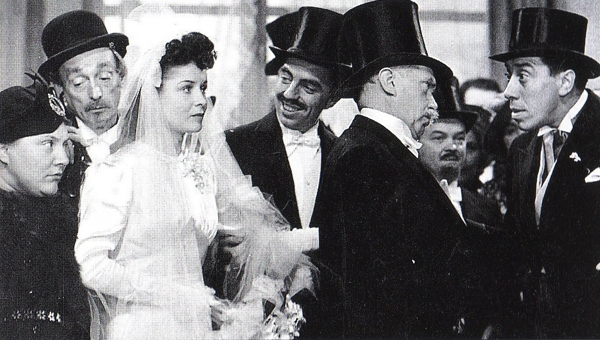
If you saw Les deux timides you may notice that Jim Gerald, who played the hero’s rival (and former client) in that film, plays the Husband in this. Other players who appeared in both films are Paul Ollivier and Pré fils. (Sorry, we have no information about any of these actors).
* * *
Do any of you remember an English comedian named Richard Hearne (“Mr Pastry”) who appeared frequently on the Ed Sullivan show and was a star at the CNE Grandstand show in 1956? One of his specialty acts was an impersonation of a somewhat elderly gentleman taking part in a square dance or a lancers. Whenever I saw this act, it always reminded me of one of the episodes in The Italian Straw Hat, and in my own mind I am convinced that Hearne must have seen this film and that he got his idea from it. If you ever saw him do this number (and it was a masterpiece of pantomime) you will undoubtedly recognize the scene I am referring to, which occurs during the wedding party.
~~~~~~~~~~~~~~~~~~~~~~~~~~~~~~~~~~~~~~~~~~~~~~~~~~~~~~~~~~~~~~~~~~~~~~~~~~~~~
APPENDIX
A Supplement to the notes for Program 3 (Jan 23)
For the record, and for those who are interested, here is the cast of The Mollycoddle, as laboriously copied down from the film with the aid of a magnifying glass:
Richard Marshall III)
Richard Marshal IV )……….Douglas Fairbanks
Richard Marshall V )
Henry Van Halker…………….Wallace Beery
American) (Morris Hughes
College )………………………..(George Stewart
Boys ) (Paul Burns
Virginia Hale…………………….Ruth Renick
Mrs Warren………………………Adele Garrington
Molly Warren……………………Betty Bouton
(Note that they spell her name “Rencik: and not “Renwick” as we had it in the credits. The latter spelling we got from Blum’s Pictorial History of the Silent Screen, which was our only source of information for the leading lady’s name prior to the arrival of the film itself).
~~~~~~~~~~~~~~~~~~~~~~~~~~~~~~~~~~~~~~~~~~~~~~~~~~~~~~~~~~~~~~~~~~~~~~~~~~~~~
Take note that our next show is only three weeks away: Monday March 20. The feature will be F.W. (The Last Laugh) Murnau’s Sunrise, starring Janet Gaynor and George O’Brien, and we hope there’ll also be a Buster Keaton short.
And four weeks after that, on April 17, Paul (Waxworks) Leni’s The Cat and the Canary, our final show of the season.
Program Notes by Fraser Macdonald

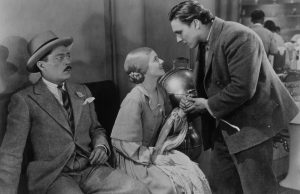
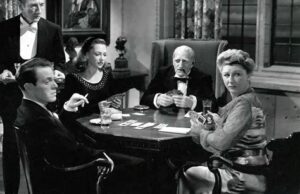
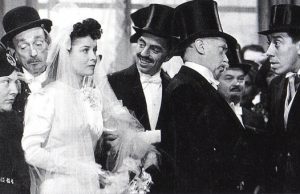






Leave a Reply